NUR3004: Preparing for practice
VerifiedAdded on 2021/09/17
|16
|4090
|63
AI Summary
Contribute Materials
Your contribution can guide someone’s learning journey. Share your
documents today.
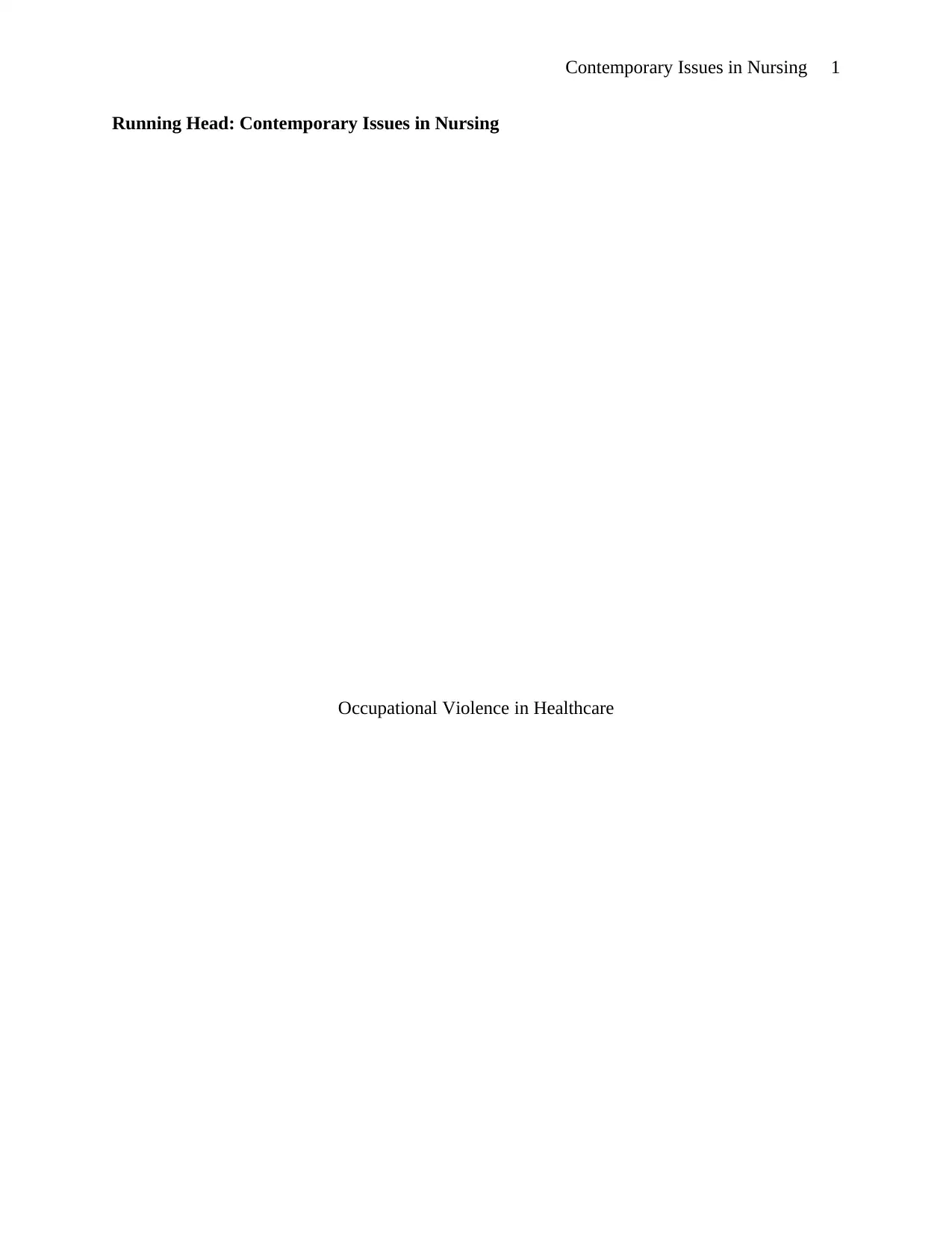
Contemporary Issues in Nursing 1
Running Head: Contemporary Issues in Nursing
Occupational Violence in Healthcare
Running Head: Contemporary Issues in Nursing
Occupational Violence in Healthcare
Secure Best Marks with AI Grader
Need help grading? Try our AI Grader for instant feedback on your assignments.
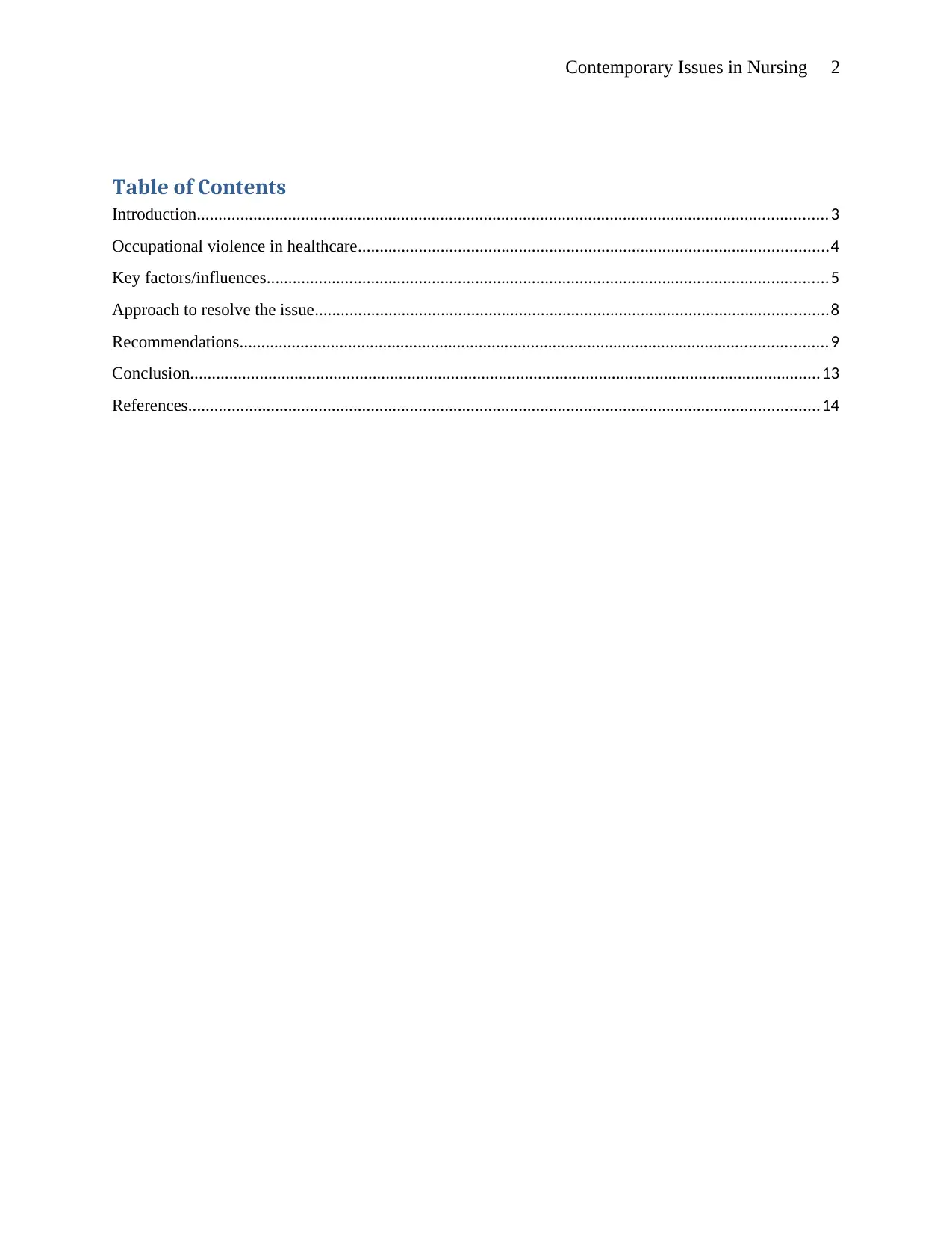
Contemporary Issues in Nursing 2
Table of Contents
Introduction.................................................................................................................................................3
Occupational violence in healthcare............................................................................................................4
Key factors/influences.................................................................................................................................5
Approach to resolve the issue......................................................................................................................8
Recommendations.......................................................................................................................................9
Conclusion.................................................................................................................................................13
References.................................................................................................................................................14
Table of Contents
Introduction.................................................................................................................................................3
Occupational violence in healthcare............................................................................................................4
Key factors/influences.................................................................................................................................5
Approach to resolve the issue......................................................................................................................8
Recommendations.......................................................................................................................................9
Conclusion.................................................................................................................................................13
References.................................................................................................................................................14
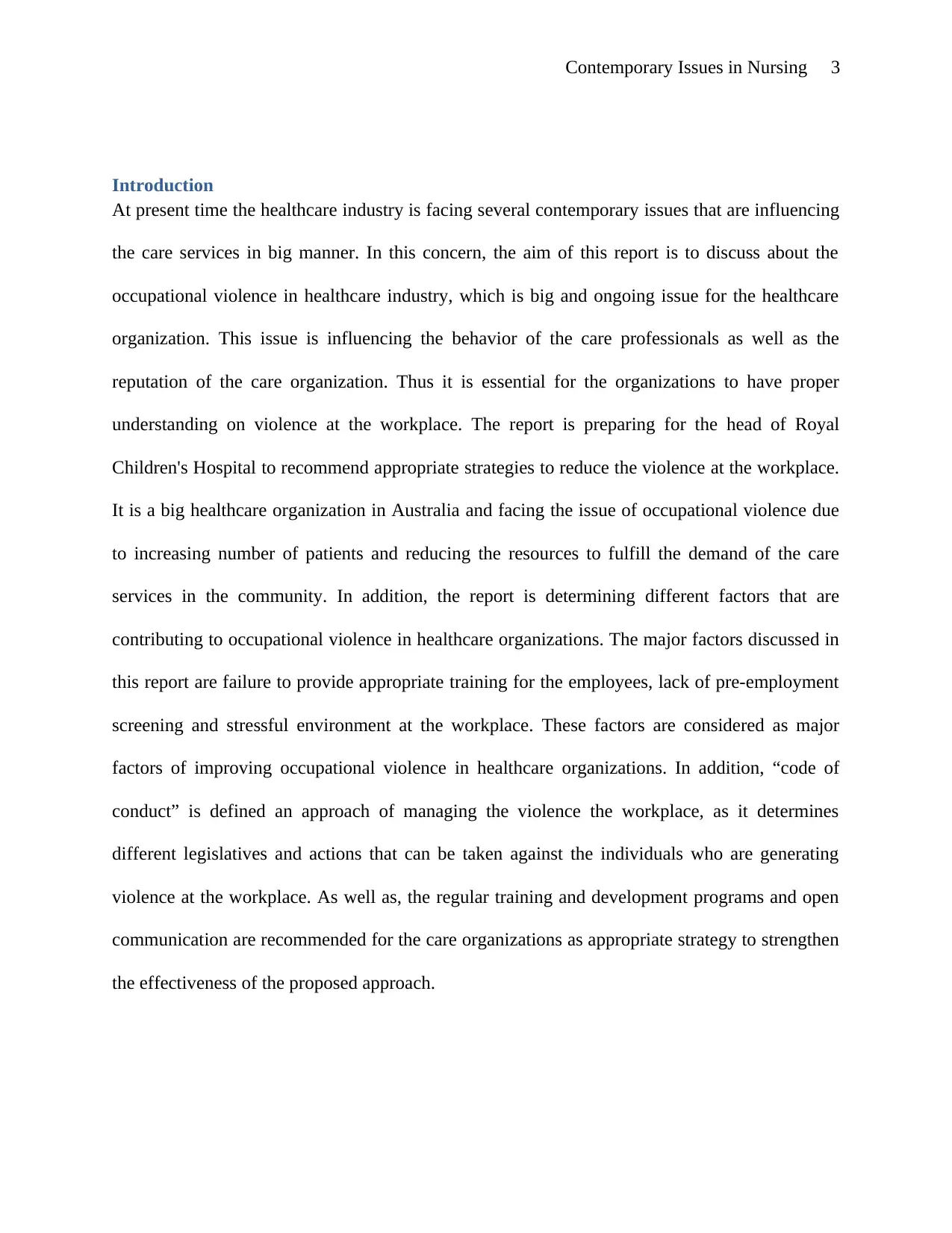
Contemporary Issues in Nursing 3
Introduction
At present time the healthcare industry is facing several contemporary issues that are influencing
the care services in big manner. In this concern, the aim of this report is to discuss about the
occupational violence in healthcare industry, which is big and ongoing issue for the healthcare
organization. This issue is influencing the behavior of the care professionals as well as the
reputation of the care organization. Thus it is essential for the organizations to have proper
understanding on violence at the workplace. The report is preparing for the head of Royal
Children's Hospital to recommend appropriate strategies to reduce the violence at the workplace.
It is a big healthcare organization in Australia and facing the issue of occupational violence due
to increasing number of patients and reducing the resources to fulfill the demand of the care
services in the community. In addition, the report is determining different factors that are
contributing to occupational violence in healthcare organizations. The major factors discussed in
this report are failure to provide appropriate training for the employees, lack of pre-employment
screening and stressful environment at the workplace. These factors are considered as major
factors of improving occupational violence in healthcare organizations. In addition, “code of
conduct” is defined an approach of managing the violence the workplace, as it determines
different legislatives and actions that can be taken against the individuals who are generating
violence at the workplace. As well as, the regular training and development programs and open
communication are recommended for the care organizations as appropriate strategy to strengthen
the effectiveness of the proposed approach.
Introduction
At present time the healthcare industry is facing several contemporary issues that are influencing
the care services in big manner. In this concern, the aim of this report is to discuss about the
occupational violence in healthcare industry, which is big and ongoing issue for the healthcare
organization. This issue is influencing the behavior of the care professionals as well as the
reputation of the care organization. Thus it is essential for the organizations to have proper
understanding on violence at the workplace. The report is preparing for the head of Royal
Children's Hospital to recommend appropriate strategies to reduce the violence at the workplace.
It is a big healthcare organization in Australia and facing the issue of occupational violence due
to increasing number of patients and reducing the resources to fulfill the demand of the care
services in the community. In addition, the report is determining different factors that are
contributing to occupational violence in healthcare organizations. The major factors discussed in
this report are failure to provide appropriate training for the employees, lack of pre-employment
screening and stressful environment at the workplace. These factors are considered as major
factors of improving occupational violence in healthcare organizations. In addition, “code of
conduct” is defined an approach of managing the violence the workplace, as it determines
different legislatives and actions that can be taken against the individuals who are generating
violence at the workplace. As well as, the regular training and development programs and open
communication are recommended for the care organizations as appropriate strategy to strengthen
the effectiveness of the proposed approach.
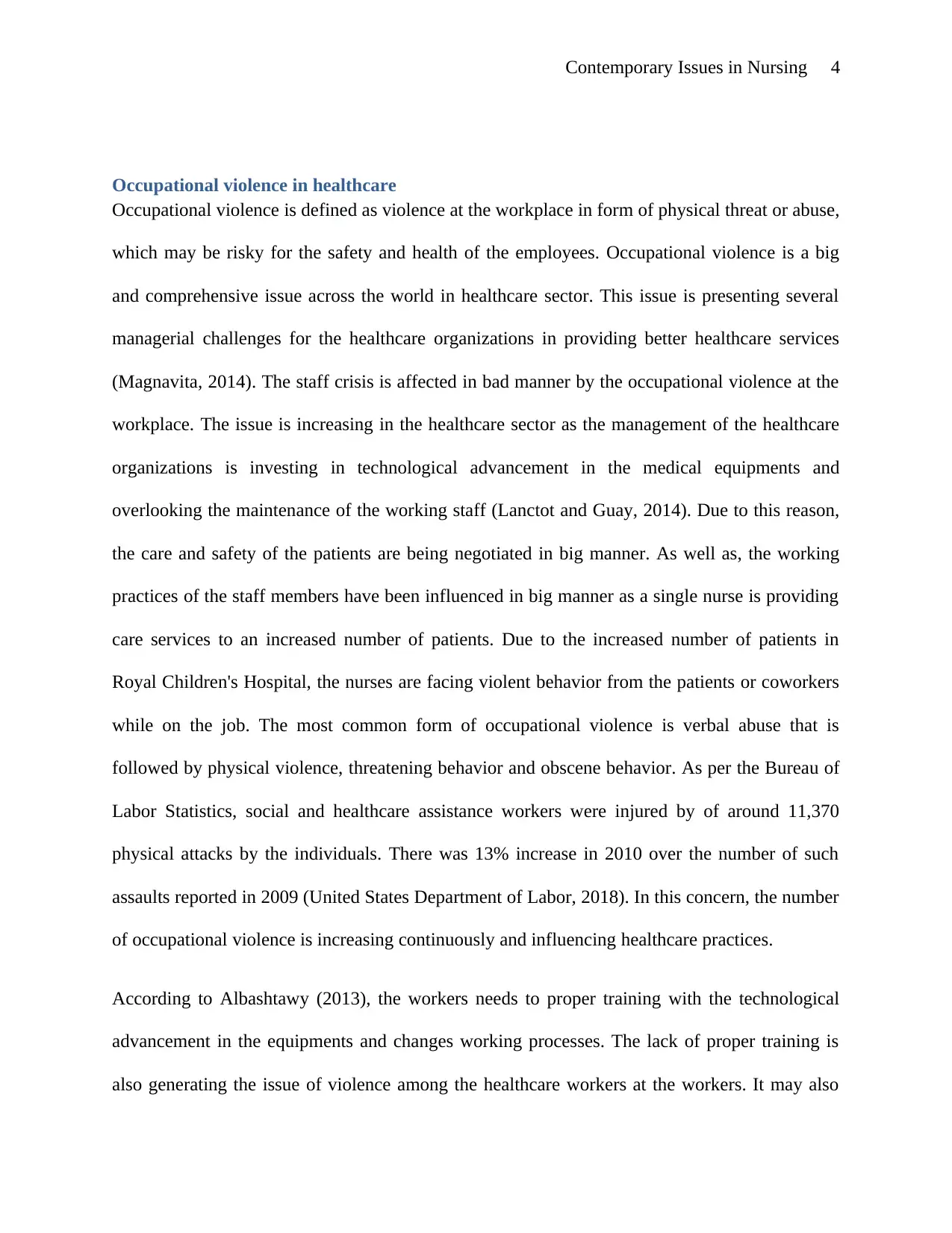
Contemporary Issues in Nursing 4
Occupational violence in healthcare
Occupational violence is defined as violence at the workplace in form of physical threat or abuse,
which may be risky for the safety and health of the employees. Occupational violence is a big
and comprehensive issue across the world in healthcare sector. This issue is presenting several
managerial challenges for the healthcare organizations in providing better healthcare services
(Magnavita, 2014). The staff crisis is affected in bad manner by the occupational violence at the
workplace. The issue is increasing in the healthcare sector as the management of the healthcare
organizations is investing in technological advancement in the medical equipments and
overlooking the maintenance of the working staff (Lanctot and Guay, 2014). Due to this reason,
the care and safety of the patients are being negotiated in big manner. As well as, the working
practices of the staff members have been influenced in big manner as a single nurse is providing
care services to an increased number of patients. Due to the increased number of patients in
Royal Children's Hospital, the nurses are facing violent behavior from the patients or coworkers
while on the job. The most common form of occupational violence is verbal abuse that is
followed by physical violence, threatening behavior and obscene behavior. As per the Bureau of
Labor Statistics, social and healthcare assistance workers were injured by of around 11,370
physical attacks by the individuals. There was 13% increase in 2010 over the number of such
assaults reported in 2009 (United States Department of Labor, 2018). In this concern, the number
of occupational violence is increasing continuously and influencing healthcare practices.
According to Albashtawy (2013), the workers needs to proper training with the technological
advancement in the equipments and changes working processes. The lack of proper training is
also generating the issue of violence among the healthcare workers at the workers. It may also
Occupational violence in healthcare
Occupational violence is defined as violence at the workplace in form of physical threat or abuse,
which may be risky for the safety and health of the employees. Occupational violence is a big
and comprehensive issue across the world in healthcare sector. This issue is presenting several
managerial challenges for the healthcare organizations in providing better healthcare services
(Magnavita, 2014). The staff crisis is affected in bad manner by the occupational violence at the
workplace. The issue is increasing in the healthcare sector as the management of the healthcare
organizations is investing in technological advancement in the medical equipments and
overlooking the maintenance of the working staff (Lanctot and Guay, 2014). Due to this reason,
the care and safety of the patients are being negotiated in big manner. As well as, the working
practices of the staff members have been influenced in big manner as a single nurse is providing
care services to an increased number of patients. Due to the increased number of patients in
Royal Children's Hospital, the nurses are facing violent behavior from the patients or coworkers
while on the job. The most common form of occupational violence is verbal abuse that is
followed by physical violence, threatening behavior and obscene behavior. As per the Bureau of
Labor Statistics, social and healthcare assistance workers were injured by of around 11,370
physical attacks by the individuals. There was 13% increase in 2010 over the number of such
assaults reported in 2009 (United States Department of Labor, 2018). In this concern, the number
of occupational violence is increasing continuously and influencing healthcare practices.
According to Albashtawy (2013), the workers needs to proper training with the technological
advancement in the equipments and changes working processes. The lack of proper training is
also generating the issue of violence among the healthcare workers at the workers. It may also
Secure Best Marks with AI Grader
Need help grading? Try our AI Grader for instant feedback on your assignments.
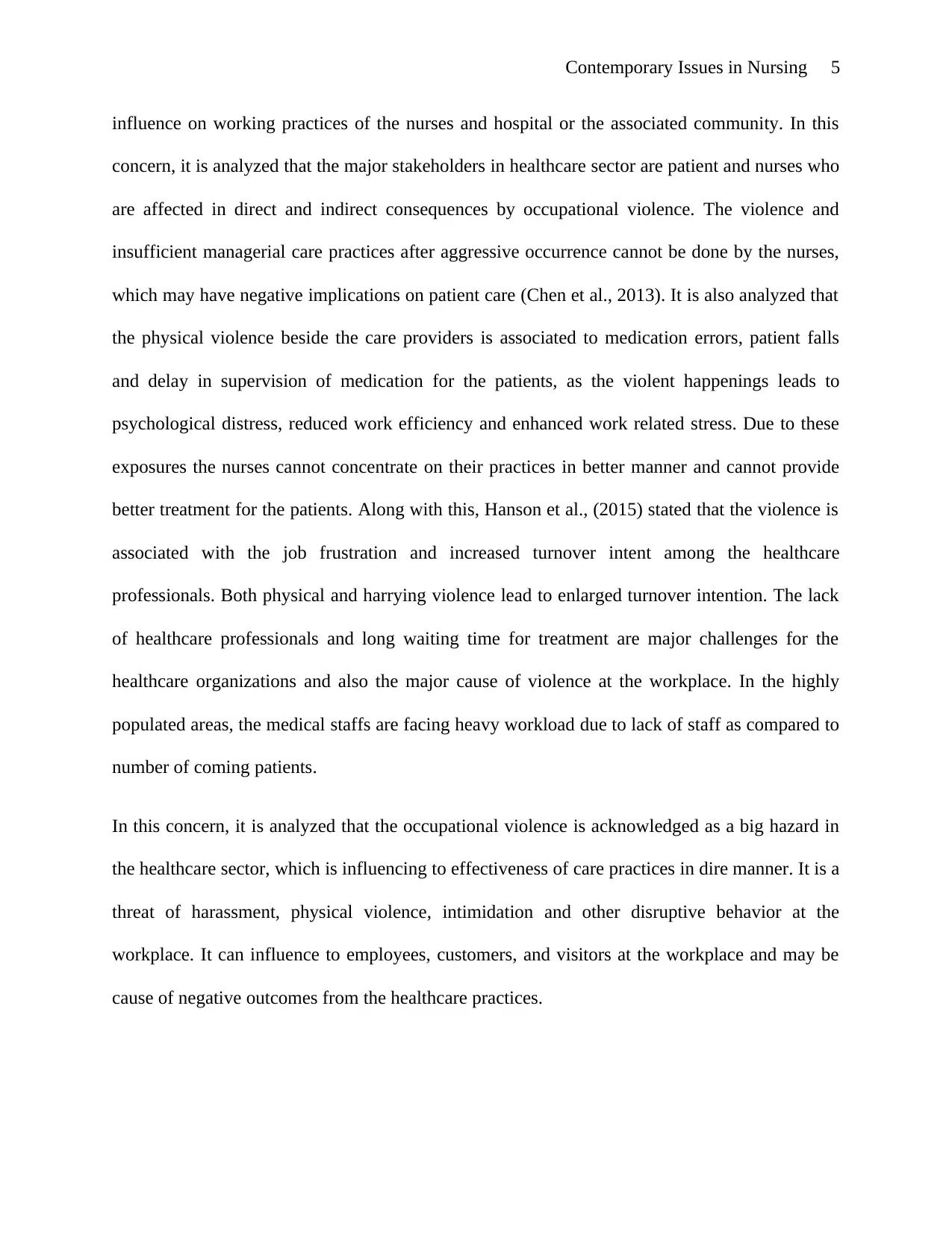
Contemporary Issues in Nursing 5
influence on working practices of the nurses and hospital or the associated community. In this
concern, it is analyzed that the major stakeholders in healthcare sector are patient and nurses who
are affected in direct and indirect consequences by occupational violence. The violence and
insufficient managerial care practices after aggressive occurrence cannot be done by the nurses,
which may have negative implications on patient care (Chen et al., 2013). It is also analyzed that
the physical violence beside the care providers is associated to medication errors, patient falls
and delay in supervision of medication for the patients, as the violent happenings leads to
psychological distress, reduced work efficiency and enhanced work related stress. Due to these
exposures the nurses cannot concentrate on their practices in better manner and cannot provide
better treatment for the patients. Along with this, Hanson et al., (2015) stated that the violence is
associated with the job frustration and increased turnover intent among the healthcare
professionals. Both physical and harrying violence lead to enlarged turnover intention. The lack
of healthcare professionals and long waiting time for treatment are major challenges for the
healthcare organizations and also the major cause of violence at the workplace. In the highly
populated areas, the medical staffs are facing heavy workload due to lack of staff as compared to
number of coming patients.
In this concern, it is analyzed that the occupational violence is acknowledged as a big hazard in
the healthcare sector, which is influencing to effectiveness of care practices in dire manner. It is a
threat of harassment, physical violence, intimidation and other disruptive behavior at the
workplace. It can influence to employees, customers, and visitors at the workplace and may be
cause of negative outcomes from the healthcare practices.
influence on working practices of the nurses and hospital or the associated community. In this
concern, it is analyzed that the major stakeholders in healthcare sector are patient and nurses who
are affected in direct and indirect consequences by occupational violence. The violence and
insufficient managerial care practices after aggressive occurrence cannot be done by the nurses,
which may have negative implications on patient care (Chen et al., 2013). It is also analyzed that
the physical violence beside the care providers is associated to medication errors, patient falls
and delay in supervision of medication for the patients, as the violent happenings leads to
psychological distress, reduced work efficiency and enhanced work related stress. Due to these
exposures the nurses cannot concentrate on their practices in better manner and cannot provide
better treatment for the patients. Along with this, Hanson et al., (2015) stated that the violence is
associated with the job frustration and increased turnover intent among the healthcare
professionals. Both physical and harrying violence lead to enlarged turnover intention. The lack
of healthcare professionals and long waiting time for treatment are major challenges for the
healthcare organizations and also the major cause of violence at the workplace. In the highly
populated areas, the medical staffs are facing heavy workload due to lack of staff as compared to
number of coming patients.
In this concern, it is analyzed that the occupational violence is acknowledged as a big hazard in
the healthcare sector, which is influencing to effectiveness of care practices in dire manner. It is a
threat of harassment, physical violence, intimidation and other disruptive behavior at the
workplace. It can influence to employees, customers, and visitors at the workplace and may be
cause of negative outcomes from the healthcare practices.
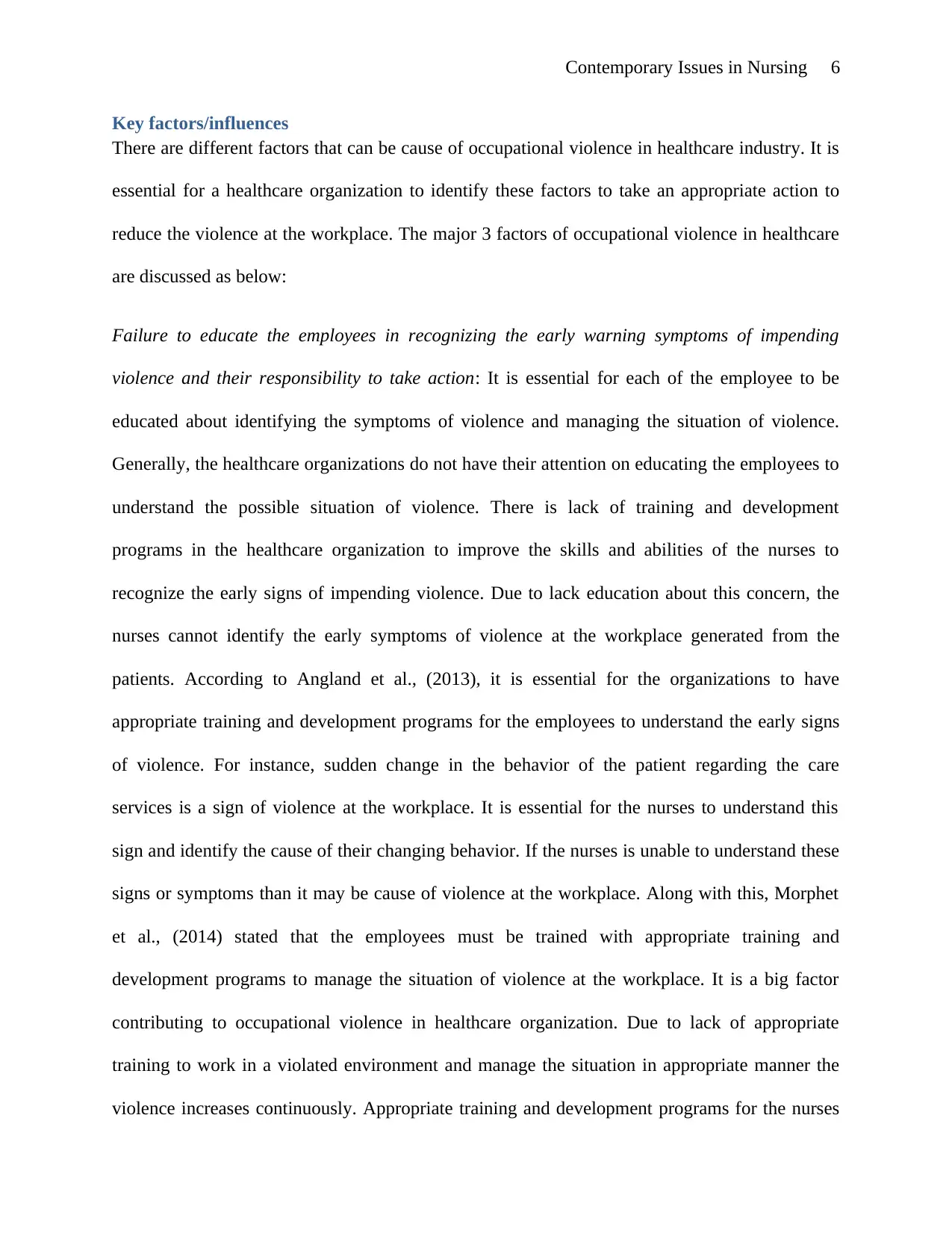
Contemporary Issues in Nursing 6
Key factors/influences
There are different factors that can be cause of occupational violence in healthcare industry. It is
essential for a healthcare organization to identify these factors to take an appropriate action to
reduce the violence at the workplace. The major 3 factors of occupational violence in healthcare
are discussed as below:
Failure to educate the employees in recognizing the early warning symptoms of impending
violence and their responsibility to take action: It is essential for each of the employee to be
educated about identifying the symptoms of violence and managing the situation of violence.
Generally, the healthcare organizations do not have their attention on educating the employees to
understand the possible situation of violence. There is lack of training and development
programs in the healthcare organization to improve the skills and abilities of the nurses to
recognize the early signs of impending violence. Due to lack education about this concern, the
nurses cannot identify the early symptoms of violence at the workplace generated from the
patients. According to Angland et al., (2013), it is essential for the organizations to have
appropriate training and development programs for the employees to understand the early signs
of violence. For instance, sudden change in the behavior of the patient regarding the care
services is a sign of violence at the workplace. It is essential for the nurses to understand this
sign and identify the cause of their changing behavior. If the nurses is unable to understand these
signs or symptoms than it may be cause of violence at the workplace. Along with this, Morphet
et al., (2014) stated that the employees must be trained with appropriate training and
development programs to manage the situation of violence at the workplace. It is a big factor
contributing to occupational violence in healthcare organization. Due to lack of appropriate
training to work in a violated environment and manage the situation in appropriate manner the
violence increases continuously. Appropriate training and development programs for the nurses
Key factors/influences
There are different factors that can be cause of occupational violence in healthcare industry. It is
essential for a healthcare organization to identify these factors to take an appropriate action to
reduce the violence at the workplace. The major 3 factors of occupational violence in healthcare
are discussed as below:
Failure to educate the employees in recognizing the early warning symptoms of impending
violence and their responsibility to take action: It is essential for each of the employee to be
educated about identifying the symptoms of violence and managing the situation of violence.
Generally, the healthcare organizations do not have their attention on educating the employees to
understand the possible situation of violence. There is lack of training and development
programs in the healthcare organization to improve the skills and abilities of the nurses to
recognize the early signs of impending violence. Due to lack education about this concern, the
nurses cannot identify the early symptoms of violence at the workplace generated from the
patients. According to Angland et al., (2013), it is essential for the organizations to have
appropriate training and development programs for the employees to understand the early signs
of violence. For instance, sudden change in the behavior of the patient regarding the care
services is a sign of violence at the workplace. It is essential for the nurses to understand this
sign and identify the cause of their changing behavior. If the nurses is unable to understand these
signs or symptoms than it may be cause of violence at the workplace. Along with this, Morphet
et al., (2014) stated that the employees must be trained with appropriate training and
development programs to manage the situation of violence at the workplace. It is a big factor
contributing to occupational violence in healthcare organization. Due to lack of appropriate
training to work in a violated environment and manage the situation in appropriate manner the
violence increases continuously. Appropriate training and development programs for the nurses
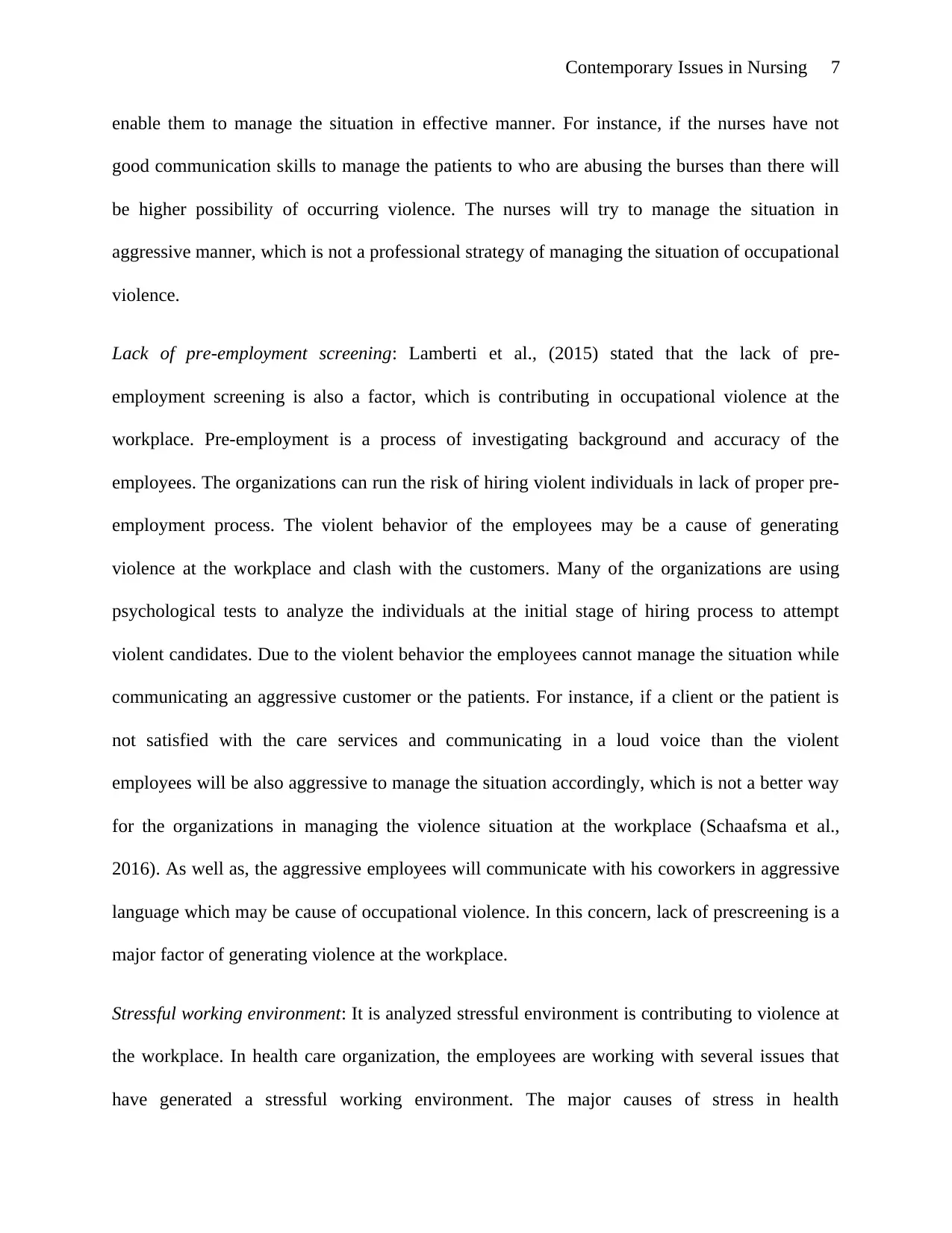
Contemporary Issues in Nursing 7
enable them to manage the situation in effective manner. For instance, if the nurses have not
good communication skills to manage the patients to who are abusing the burses than there will
be higher possibility of occurring violence. The nurses will try to manage the situation in
aggressive manner, which is not a professional strategy of managing the situation of occupational
violence.
Lack of pre-employment screening: Lamberti et al., (2015) stated that the lack of pre-
employment screening is also a factor, which is contributing in occupational violence at the
workplace. Pre-employment is a process of investigating background and accuracy of the
employees. The organizations can run the risk of hiring violent individuals in lack of proper pre-
employment process. The violent behavior of the employees may be a cause of generating
violence at the workplace and clash with the customers. Many of the organizations are using
psychological tests to analyze the individuals at the initial stage of hiring process to attempt
violent candidates. Due to the violent behavior the employees cannot manage the situation while
communicating an aggressive customer or the patients. For instance, if a client or the patient is
not satisfied with the care services and communicating in a loud voice than the violent
employees will be also aggressive to manage the situation accordingly, which is not a better way
for the organizations in managing the violence situation at the workplace (Schaafsma et al.,
2016). As well as, the aggressive employees will communicate with his coworkers in aggressive
language which may be cause of occupational violence. In this concern, lack of prescreening is a
major factor of generating violence at the workplace.
Stressful working environment: It is analyzed stressful environment is contributing to violence at
the workplace. In health care organization, the employees are working with several issues that
have generated a stressful working environment. The major causes of stress in health
enable them to manage the situation in effective manner. For instance, if the nurses have not
good communication skills to manage the patients to who are abusing the burses than there will
be higher possibility of occurring violence. The nurses will try to manage the situation in
aggressive manner, which is not a professional strategy of managing the situation of occupational
violence.
Lack of pre-employment screening: Lamberti et al., (2015) stated that the lack of pre-
employment screening is also a factor, which is contributing in occupational violence at the
workplace. Pre-employment is a process of investigating background and accuracy of the
employees. The organizations can run the risk of hiring violent individuals in lack of proper pre-
employment process. The violent behavior of the employees may be a cause of generating
violence at the workplace and clash with the customers. Many of the organizations are using
psychological tests to analyze the individuals at the initial stage of hiring process to attempt
violent candidates. Due to the violent behavior the employees cannot manage the situation while
communicating an aggressive customer or the patients. For instance, if a client or the patient is
not satisfied with the care services and communicating in a loud voice than the violent
employees will be also aggressive to manage the situation accordingly, which is not a better way
for the organizations in managing the violence situation at the workplace (Schaafsma et al.,
2016). As well as, the aggressive employees will communicate with his coworkers in aggressive
language which may be cause of occupational violence. In this concern, lack of prescreening is a
major factor of generating violence at the workplace.
Stressful working environment: It is analyzed stressful environment is contributing to violence at
the workplace. In health care organization, the employees are working with several issues that
have generated a stressful working environment. The major causes of stress in health
Paraphrase This Document
Need a fresh take? Get an instant paraphrase of this document with our AI Paraphraser
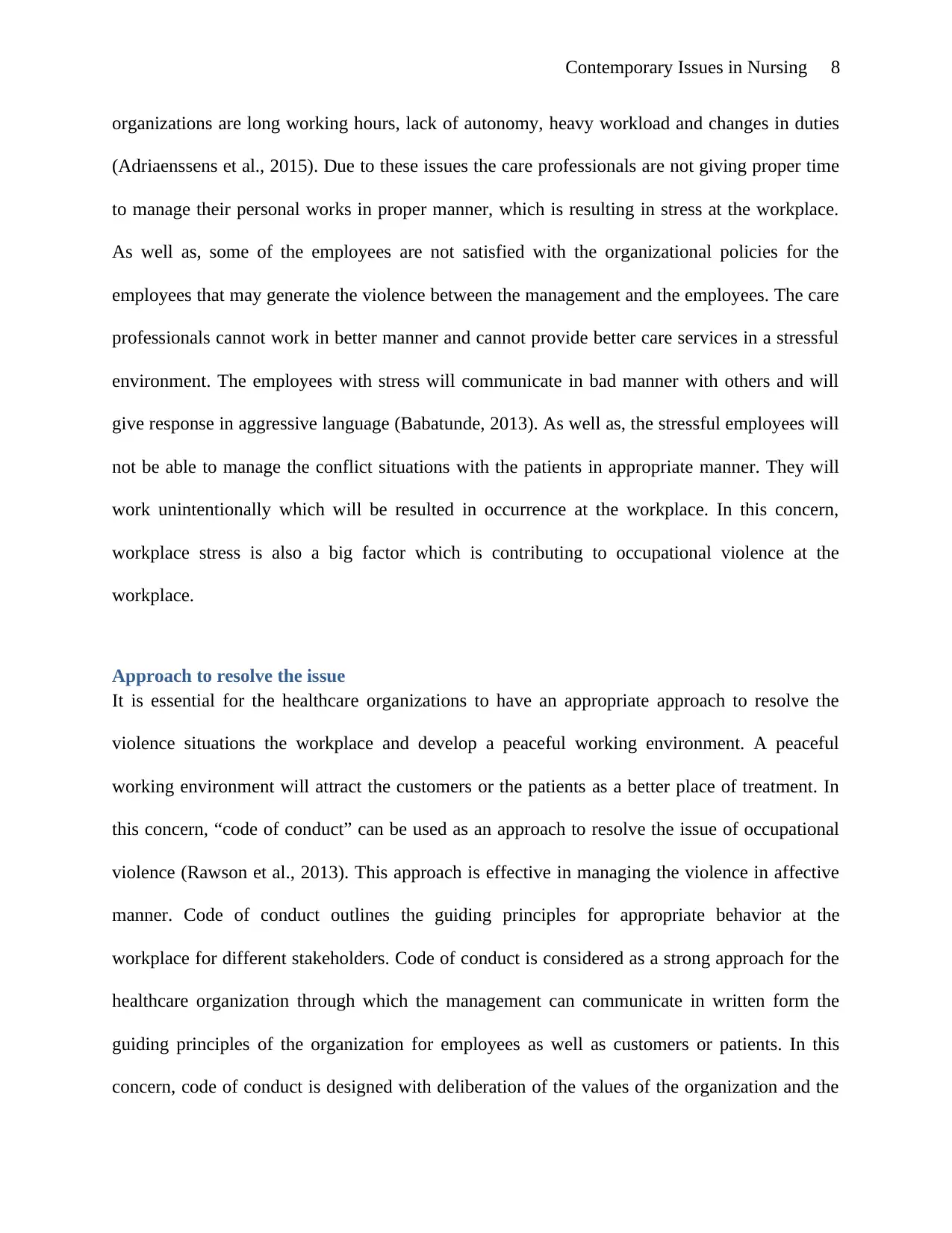
Contemporary Issues in Nursing 8
organizations are long working hours, lack of autonomy, heavy workload and changes in duties
(Adriaenssens et al., 2015). Due to these issues the care professionals are not giving proper time
to manage their personal works in proper manner, which is resulting in stress at the workplace.
As well as, some of the employees are not satisfied with the organizational policies for the
employees that may generate the violence between the management and the employees. The care
professionals cannot work in better manner and cannot provide better care services in a stressful
environment. The employees with stress will communicate in bad manner with others and will
give response in aggressive language (Babatunde, 2013). As well as, the stressful employees will
not be able to manage the conflict situations with the patients in appropriate manner. They will
work unintentionally which will be resulted in occurrence at the workplace. In this concern,
workplace stress is also a big factor which is contributing to occupational violence at the
workplace.
Approach to resolve the issue
It is essential for the healthcare organizations to have an appropriate approach to resolve the
violence situations the workplace and develop a peaceful working environment. A peaceful
working environment will attract the customers or the patients as a better place of treatment. In
this concern, “code of conduct” can be used as an approach to resolve the issue of occupational
violence (Rawson et al., 2013). This approach is effective in managing the violence in affective
manner. Code of conduct outlines the guiding principles for appropriate behavior at the
workplace for different stakeholders. Code of conduct is considered as a strong approach for the
healthcare organization through which the management can communicate in written form the
guiding principles of the organization for employees as well as customers or patients. In this
concern, code of conduct is designed with deliberation of the values of the organization and the
organizations are long working hours, lack of autonomy, heavy workload and changes in duties
(Adriaenssens et al., 2015). Due to these issues the care professionals are not giving proper time
to manage their personal works in proper manner, which is resulting in stress at the workplace.
As well as, some of the employees are not satisfied with the organizational policies for the
employees that may generate the violence between the management and the employees. The care
professionals cannot work in better manner and cannot provide better care services in a stressful
environment. The employees with stress will communicate in bad manner with others and will
give response in aggressive language (Babatunde, 2013). As well as, the stressful employees will
not be able to manage the conflict situations with the patients in appropriate manner. They will
work unintentionally which will be resulted in occurrence at the workplace. In this concern,
workplace stress is also a big factor which is contributing to occupational violence at the
workplace.
Approach to resolve the issue
It is essential for the healthcare organizations to have an appropriate approach to resolve the
violence situations the workplace and develop a peaceful working environment. A peaceful
working environment will attract the customers or the patients as a better place of treatment. In
this concern, “code of conduct” can be used as an approach to resolve the issue of occupational
violence (Rawson et al., 2013). This approach is effective in managing the violence in affective
manner. Code of conduct outlines the guiding principles for appropriate behavior at the
workplace for different stakeholders. Code of conduct is considered as a strong approach for the
healthcare organization through which the management can communicate in written form the
guiding principles of the organization for employees as well as customers or patients. In this
concern, code of conduct is designed with deliberation of the values of the organization and the
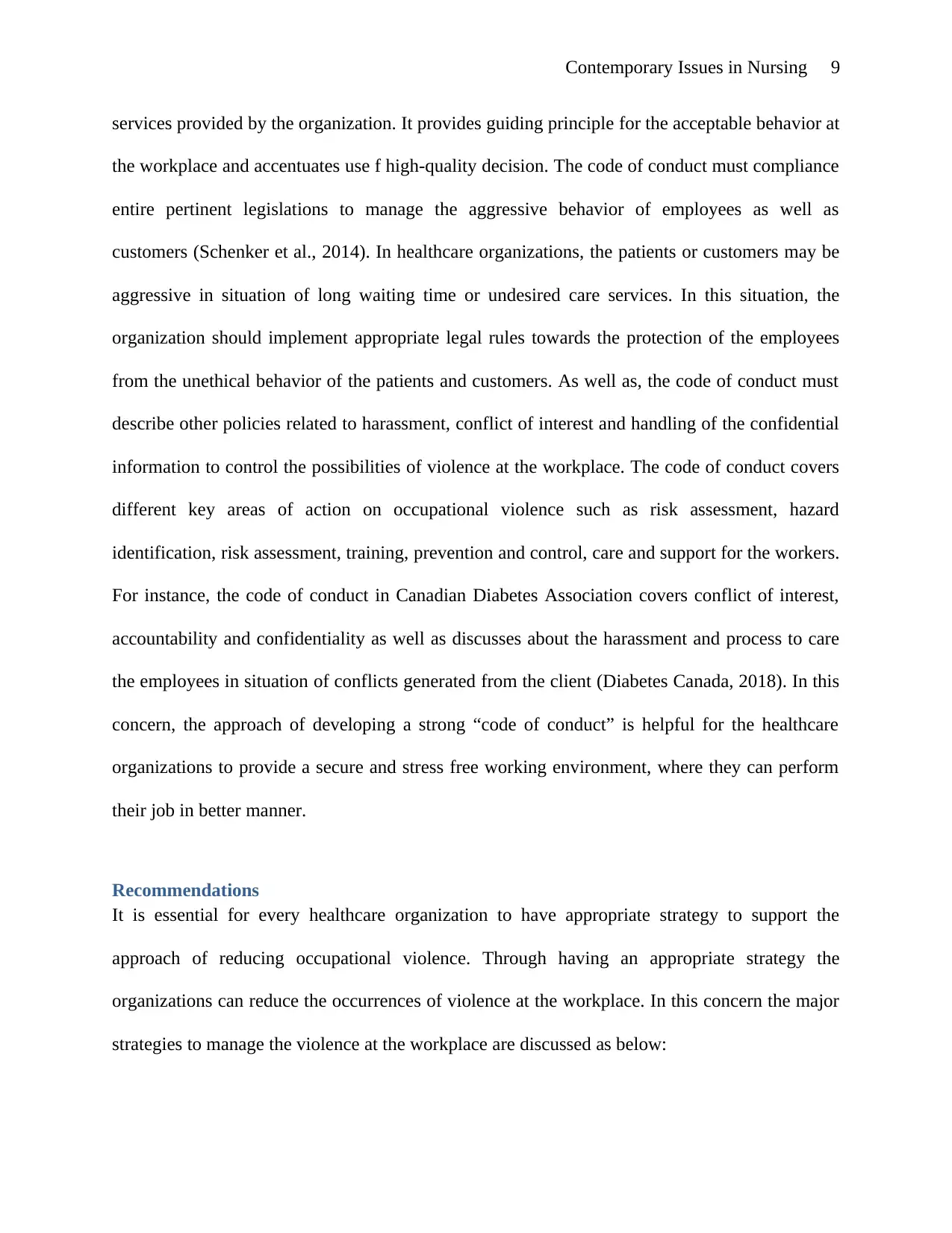
Contemporary Issues in Nursing 9
services provided by the organization. It provides guiding principle for the acceptable behavior at
the workplace and accentuates use f high-quality decision. The code of conduct must compliance
entire pertinent legislations to manage the aggressive behavior of employees as well as
customers (Schenker et al., 2014). In healthcare organizations, the patients or customers may be
aggressive in situation of long waiting time or undesired care services. In this situation, the
organization should implement appropriate legal rules towards the protection of the employees
from the unethical behavior of the patients and customers. As well as, the code of conduct must
describe other policies related to harassment, conflict of interest and handling of the confidential
information to control the possibilities of violence at the workplace. The code of conduct covers
different key areas of action on occupational violence such as risk assessment, hazard
identification, risk assessment, training, prevention and control, care and support for the workers.
For instance, the code of conduct in Canadian Diabetes Association covers conflict of interest,
accountability and confidentiality as well as discusses about the harassment and process to care
the employees in situation of conflicts generated from the client (Diabetes Canada, 2018). In this
concern, the approach of developing a strong “code of conduct” is helpful for the healthcare
organizations to provide a secure and stress free working environment, where they can perform
their job in better manner.
Recommendations
It is essential for every healthcare organization to have appropriate strategy to support the
approach of reducing occupational violence. Through having an appropriate strategy the
organizations can reduce the occurrences of violence at the workplace. In this concern the major
strategies to manage the violence at the workplace are discussed as below:
services provided by the organization. It provides guiding principle for the acceptable behavior at
the workplace and accentuates use f high-quality decision. The code of conduct must compliance
entire pertinent legislations to manage the aggressive behavior of employees as well as
customers (Schenker et al., 2014). In healthcare organizations, the patients or customers may be
aggressive in situation of long waiting time or undesired care services. In this situation, the
organization should implement appropriate legal rules towards the protection of the employees
from the unethical behavior of the patients and customers. As well as, the code of conduct must
describe other policies related to harassment, conflict of interest and handling of the confidential
information to control the possibilities of violence at the workplace. The code of conduct covers
different key areas of action on occupational violence such as risk assessment, hazard
identification, risk assessment, training, prevention and control, care and support for the workers.
For instance, the code of conduct in Canadian Diabetes Association covers conflict of interest,
accountability and confidentiality as well as discusses about the harassment and process to care
the employees in situation of conflicts generated from the client (Diabetes Canada, 2018). In this
concern, the approach of developing a strong “code of conduct” is helpful for the healthcare
organizations to provide a secure and stress free working environment, where they can perform
their job in better manner.
Recommendations
It is essential for every healthcare organization to have appropriate strategy to support the
approach of reducing occupational violence. Through having an appropriate strategy the
organizations can reduce the occurrences of violence at the workplace. In this concern the major
strategies to manage the violence at the workplace are discussed as below:
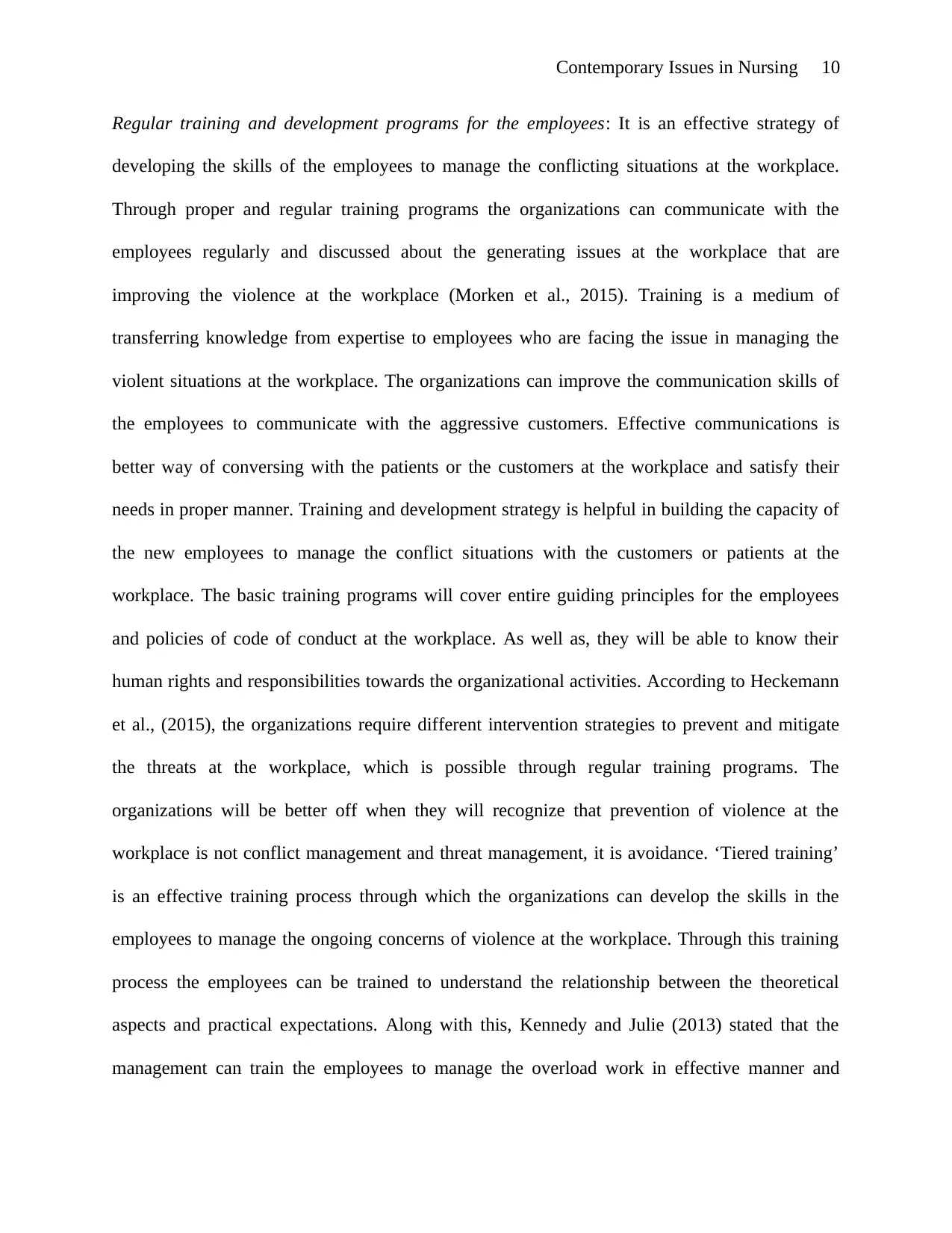
Contemporary Issues in Nursing 10
Regular training and development programs for the employees: It is an effective strategy of
developing the skills of the employees to manage the conflicting situations at the workplace.
Through proper and regular training programs the organizations can communicate with the
employees regularly and discussed about the generating issues at the workplace that are
improving the violence at the workplace (Morken et al., 2015). Training is a medium of
transferring knowledge from expertise to employees who are facing the issue in managing the
violent situations at the workplace. The organizations can improve the communication skills of
the employees to communicate with the aggressive customers. Effective communications is
better way of conversing with the patients or the customers at the workplace and satisfy their
needs in proper manner. Training and development strategy is helpful in building the capacity of
the new employees to manage the conflict situations with the customers or patients at the
workplace. The basic training programs will cover entire guiding principles for the employees
and policies of code of conduct at the workplace. As well as, they will be able to know their
human rights and responsibilities towards the organizational activities. According to Heckemann
et al., (2015), the organizations require different intervention strategies to prevent and mitigate
the threats at the workplace, which is possible through regular training programs. The
organizations will be better off when they will recognize that prevention of violence at the
workplace is not conflict management and threat management, it is avoidance. ‘Tiered training’
is an effective training process through which the organizations can develop the skills in the
employees to manage the ongoing concerns of violence at the workplace. Through this training
process the employees can be trained to understand the relationship between the theoretical
aspects and practical expectations. Along with this, Kennedy and Julie (2013) stated that the
management can train the employees to manage the overload work in effective manner and
Regular training and development programs for the employees: It is an effective strategy of
developing the skills of the employees to manage the conflicting situations at the workplace.
Through proper and regular training programs the organizations can communicate with the
employees regularly and discussed about the generating issues at the workplace that are
improving the violence at the workplace (Morken et al., 2015). Training is a medium of
transferring knowledge from expertise to employees who are facing the issue in managing the
violent situations at the workplace. The organizations can improve the communication skills of
the employees to communicate with the aggressive customers. Effective communications is
better way of conversing with the patients or the customers at the workplace and satisfy their
needs in proper manner. Training and development strategy is helpful in building the capacity of
the new employees to manage the conflict situations with the customers or patients at the
workplace. The basic training programs will cover entire guiding principles for the employees
and policies of code of conduct at the workplace. As well as, they will be able to know their
human rights and responsibilities towards the organizational activities. According to Heckemann
et al., (2015), the organizations require different intervention strategies to prevent and mitigate
the threats at the workplace, which is possible through regular training programs. The
organizations will be better off when they will recognize that prevention of violence at the
workplace is not conflict management and threat management, it is avoidance. ‘Tiered training’
is an effective training process through which the organizations can develop the skills in the
employees to manage the ongoing concerns of violence at the workplace. Through this training
process the employees can be trained to understand the relationship between the theoretical
aspects and practical expectations. Along with this, Kennedy and Julie (2013) stated that the
management can train the employees to manage the overload work in effective manner and
Secure Best Marks with AI Grader
Need help grading? Try our AI Grader for instant feedback on your assignments.
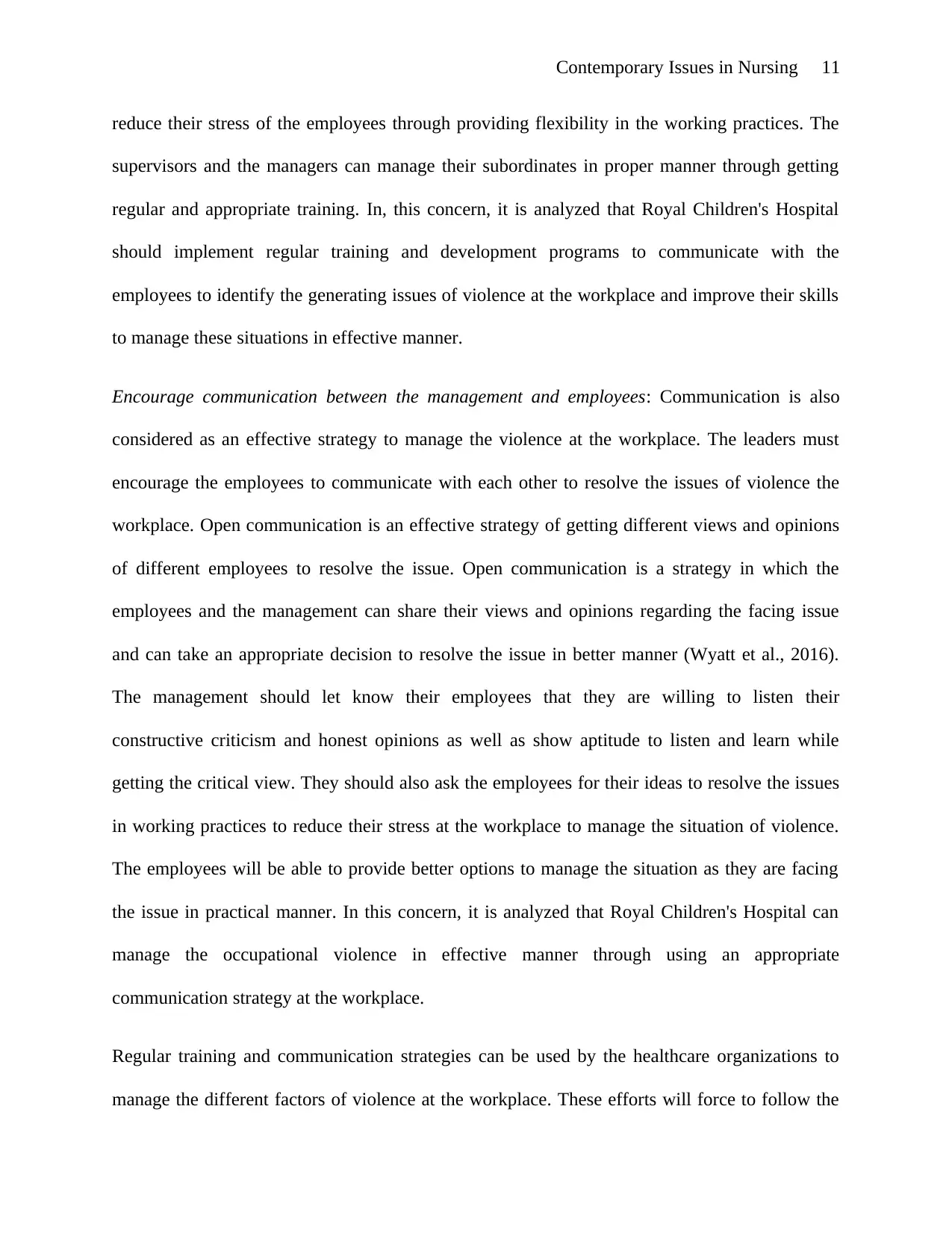
Contemporary Issues in Nursing 11
reduce their stress of the employees through providing flexibility in the working practices. The
supervisors and the managers can manage their subordinates in proper manner through getting
regular and appropriate training. In, this concern, it is analyzed that Royal Children's Hospital
should implement regular training and development programs to communicate with the
employees to identify the generating issues of violence at the workplace and improve their skills
to manage these situations in effective manner.
Encourage communication between the management and employees: Communication is also
considered as an effective strategy to manage the violence at the workplace. The leaders must
encourage the employees to communicate with each other to resolve the issues of violence the
workplace. Open communication is an effective strategy of getting different views and opinions
of different employees to resolve the issue. Open communication is a strategy in which the
employees and the management can share their views and opinions regarding the facing issue
and can take an appropriate decision to resolve the issue in better manner (Wyatt et al., 2016).
The management should let know their employees that they are willing to listen their
constructive criticism and honest opinions as well as show aptitude to listen and learn while
getting the critical view. They should also ask the employees for their ideas to resolve the issues
in working practices to reduce their stress at the workplace to manage the situation of violence.
The employees will be able to provide better options to manage the situation as they are facing
the issue in practical manner. In this concern, it is analyzed that Royal Children's Hospital can
manage the occupational violence in effective manner through using an appropriate
communication strategy at the workplace.
Regular training and communication strategies can be used by the healthcare organizations to
manage the different factors of violence at the workplace. These efforts will force to follow the
reduce their stress of the employees through providing flexibility in the working practices. The
supervisors and the managers can manage their subordinates in proper manner through getting
regular and appropriate training. In, this concern, it is analyzed that Royal Children's Hospital
should implement regular training and development programs to communicate with the
employees to identify the generating issues of violence at the workplace and improve their skills
to manage these situations in effective manner.
Encourage communication between the management and employees: Communication is also
considered as an effective strategy to manage the violence at the workplace. The leaders must
encourage the employees to communicate with each other to resolve the issues of violence the
workplace. Open communication is an effective strategy of getting different views and opinions
of different employees to resolve the issue. Open communication is a strategy in which the
employees and the management can share their views and opinions regarding the facing issue
and can take an appropriate decision to resolve the issue in better manner (Wyatt et al., 2016).
The management should let know their employees that they are willing to listen their
constructive criticism and honest opinions as well as show aptitude to listen and learn while
getting the critical view. They should also ask the employees for their ideas to resolve the issues
in working practices to reduce their stress at the workplace to manage the situation of violence.
The employees will be able to provide better options to manage the situation as they are facing
the issue in practical manner. In this concern, it is analyzed that Royal Children's Hospital can
manage the occupational violence in effective manner through using an appropriate
communication strategy at the workplace.
Regular training and communication strategies can be used by the healthcare organizations to
manage the different factors of violence at the workplace. These efforts will force to follow the
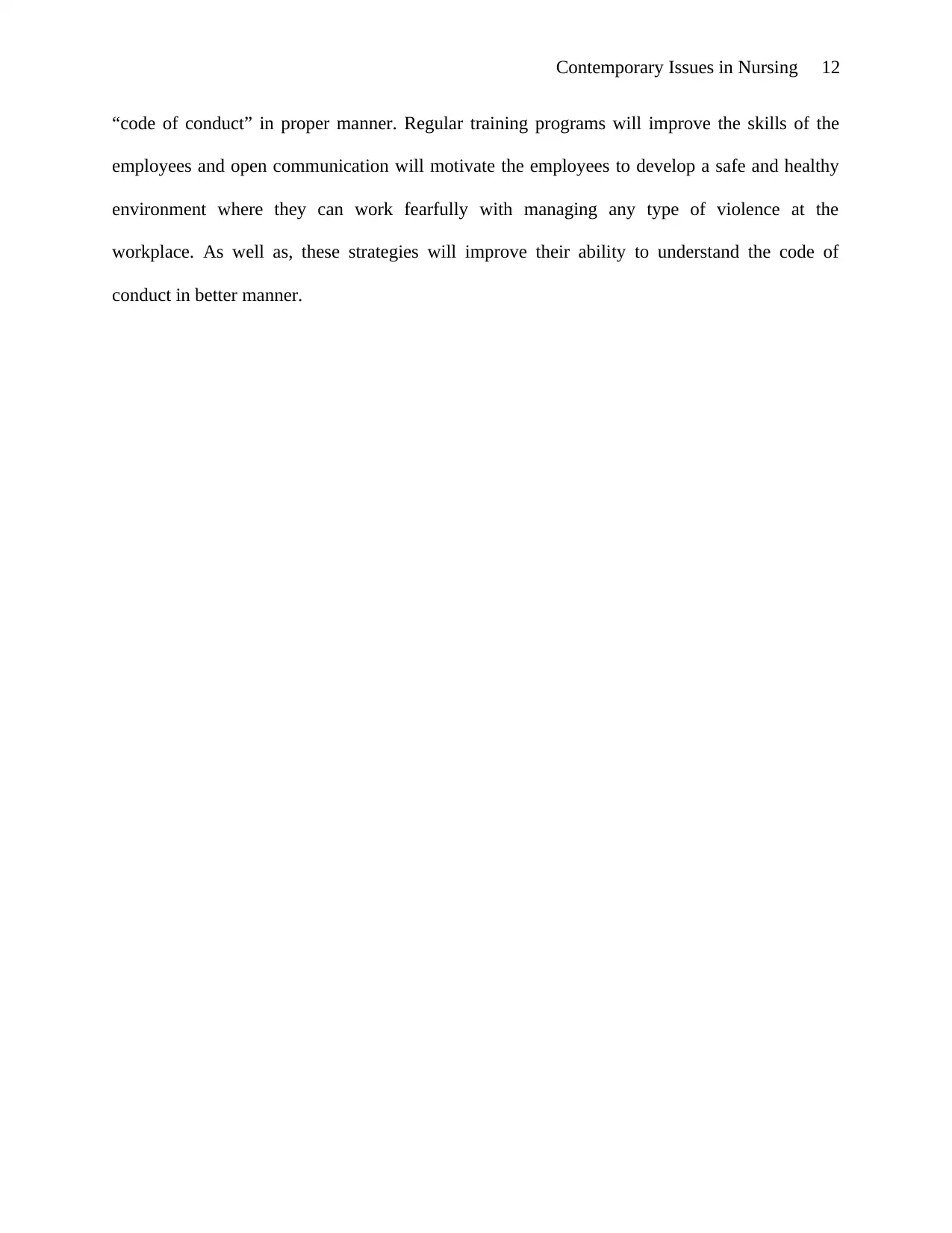
Contemporary Issues in Nursing 12
“code of conduct” in proper manner. Regular training programs will improve the skills of the
employees and open communication will motivate the employees to develop a safe and healthy
environment where they can work fearfully with managing any type of violence at the
workplace. As well as, these strategies will improve their ability to understand the code of
conduct in better manner.
“code of conduct” in proper manner. Regular training programs will improve the skills of the
employees and open communication will motivate the employees to develop a safe and healthy
environment where they can work fearfully with managing any type of violence at the
workplace. As well as, these strategies will improve their ability to understand the code of
conduct in better manner.
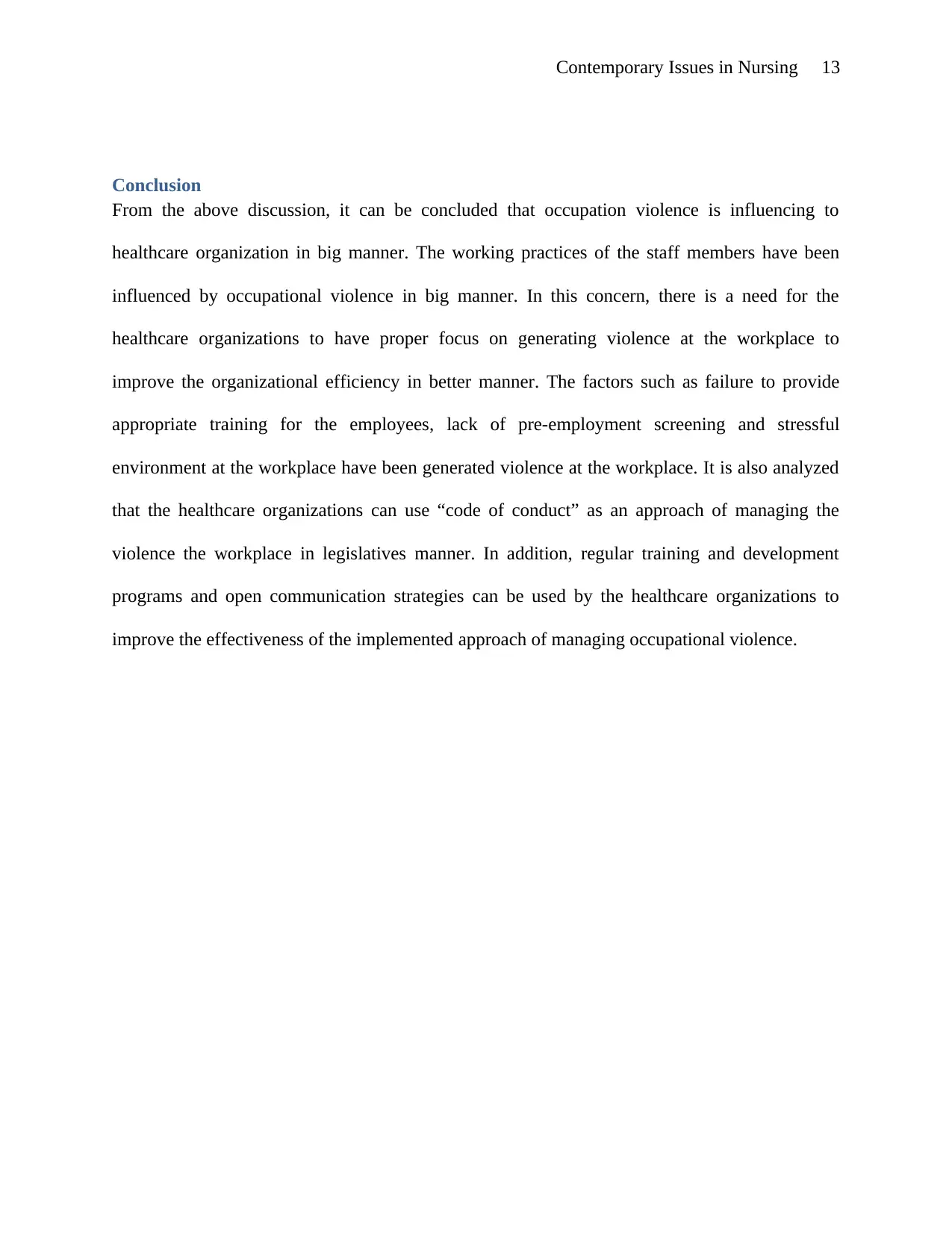
Contemporary Issues in Nursing 13
Conclusion
From the above discussion, it can be concluded that occupation violence is influencing to
healthcare organization in big manner. The working practices of the staff members have been
influenced by occupational violence in big manner. In this concern, there is a need for the
healthcare organizations to have proper focus on generating violence at the workplace to
improve the organizational efficiency in better manner. The factors such as failure to provide
appropriate training for the employees, lack of pre-employment screening and stressful
environment at the workplace have been generated violence at the workplace. It is also analyzed
that the healthcare organizations can use “code of conduct” as an approach of managing the
violence the workplace in legislatives manner. In addition, regular training and development
programs and open communication strategies can be used by the healthcare organizations to
improve the effectiveness of the implemented approach of managing occupational violence.
Conclusion
From the above discussion, it can be concluded that occupation violence is influencing to
healthcare organization in big manner. The working practices of the staff members have been
influenced by occupational violence in big manner. In this concern, there is a need for the
healthcare organizations to have proper focus on generating violence at the workplace to
improve the organizational efficiency in better manner. The factors such as failure to provide
appropriate training for the employees, lack of pre-employment screening and stressful
environment at the workplace have been generated violence at the workplace. It is also analyzed
that the healthcare organizations can use “code of conduct” as an approach of managing the
violence the workplace in legislatives manner. In addition, regular training and development
programs and open communication strategies can be used by the healthcare organizations to
improve the effectiveness of the implemented approach of managing occupational violence.
Paraphrase This Document
Need a fresh take? Get an instant paraphrase of this document with our AI Paraphraser
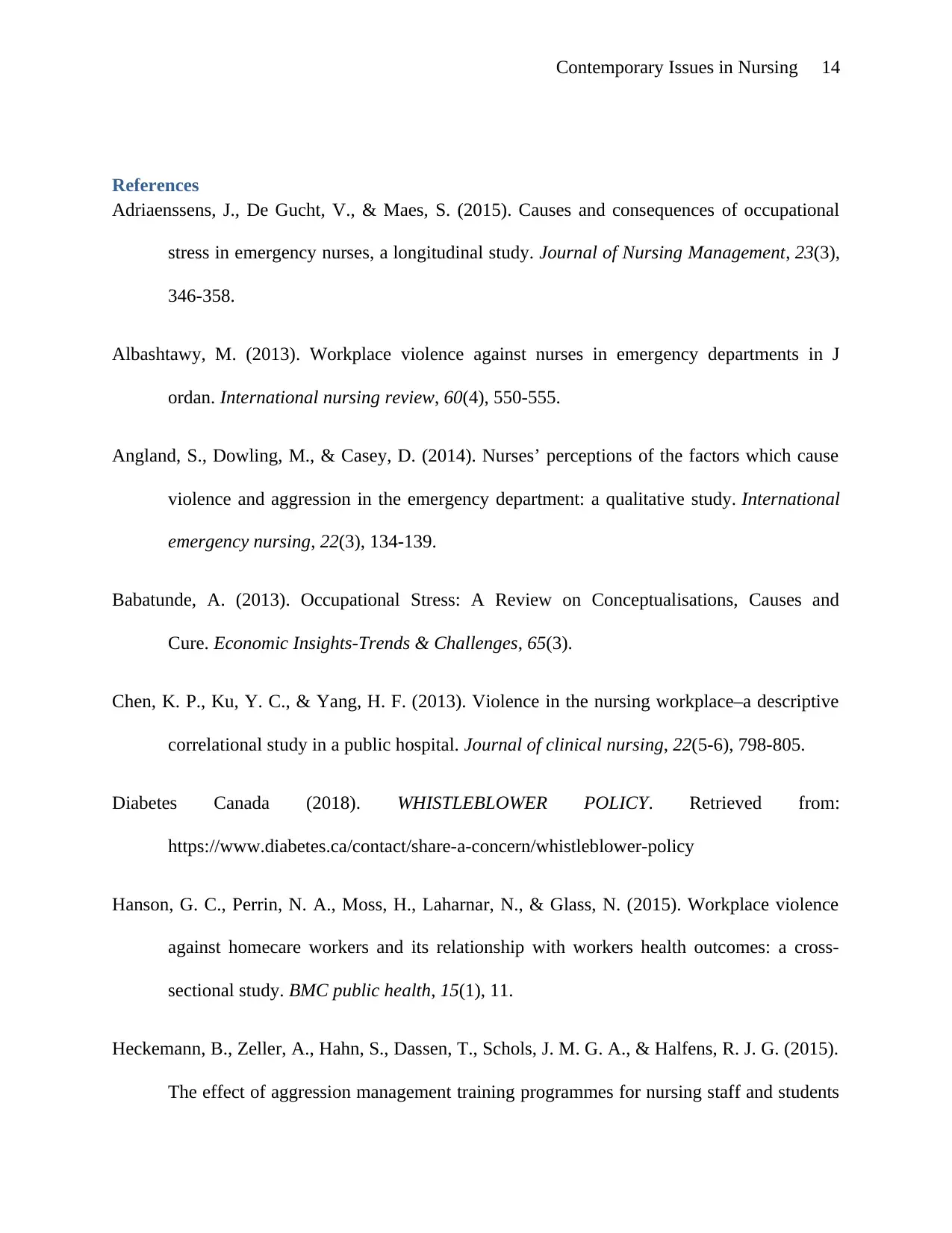
Contemporary Issues in Nursing 14
References
Adriaenssens, J., De Gucht, V., & Maes, S. (2015). Causes and consequences of occupational
stress in emergency nurses, a longitudinal study. Journal of Nursing Management, 23(3),
346-358.
Albashtawy, M. (2013). Workplace violence against nurses in emergency departments in J
ordan. International nursing review, 60(4), 550-555.
Angland, S., Dowling, M., & Casey, D. (2014). Nurses’ perceptions of the factors which cause
violence and aggression in the emergency department: a qualitative study. International
emergency nursing, 22(3), 134-139.
Babatunde, A. (2013). Occupational Stress: A Review on Conceptualisations, Causes and
Cure. Economic Insights-Trends & Challenges, 65(3).
Chen, K. P., Ku, Y. C., & Yang, H. F. (2013). Violence in the nursing workplace–a descriptive
correlational study in a public hospital. Journal of clinical nursing, 22(5-6), 798-805.
Diabetes Canada (2018). WHISTLEBLOWER POLICY. Retrieved from:
https://www.diabetes.ca/contact/share-a-concern/whistleblower-policy
Hanson, G. C., Perrin, N. A., Moss, H., Laharnar, N., & Glass, N. (2015). Workplace violence
against homecare workers and its relationship with workers health outcomes: a cross-
sectional study. BMC public health, 15(1), 11.
Heckemann, B., Zeller, A., Hahn, S., Dassen, T., Schols, J. M. G. A., & Halfens, R. J. G. (2015).
The effect of aggression management training programmes for nursing staff and students
References
Adriaenssens, J., De Gucht, V., & Maes, S. (2015). Causes and consequences of occupational
stress in emergency nurses, a longitudinal study. Journal of Nursing Management, 23(3),
346-358.
Albashtawy, M. (2013). Workplace violence against nurses in emergency departments in J
ordan. International nursing review, 60(4), 550-555.
Angland, S., Dowling, M., & Casey, D. (2014). Nurses’ perceptions of the factors which cause
violence and aggression in the emergency department: a qualitative study. International
emergency nursing, 22(3), 134-139.
Babatunde, A. (2013). Occupational Stress: A Review on Conceptualisations, Causes and
Cure. Economic Insights-Trends & Challenges, 65(3).
Chen, K. P., Ku, Y. C., & Yang, H. F. (2013). Violence in the nursing workplace–a descriptive
correlational study in a public hospital. Journal of clinical nursing, 22(5-6), 798-805.
Diabetes Canada (2018). WHISTLEBLOWER POLICY. Retrieved from:
https://www.diabetes.ca/contact/share-a-concern/whistleblower-policy
Hanson, G. C., Perrin, N. A., Moss, H., Laharnar, N., & Glass, N. (2015). Workplace violence
against homecare workers and its relationship with workers health outcomes: a cross-
sectional study. BMC public health, 15(1), 11.
Heckemann, B., Zeller, A., Hahn, S., Dassen, T., Schols, J. M. G. A., & Halfens, R. J. G. (2015).
The effect of aggression management training programmes for nursing staff and students
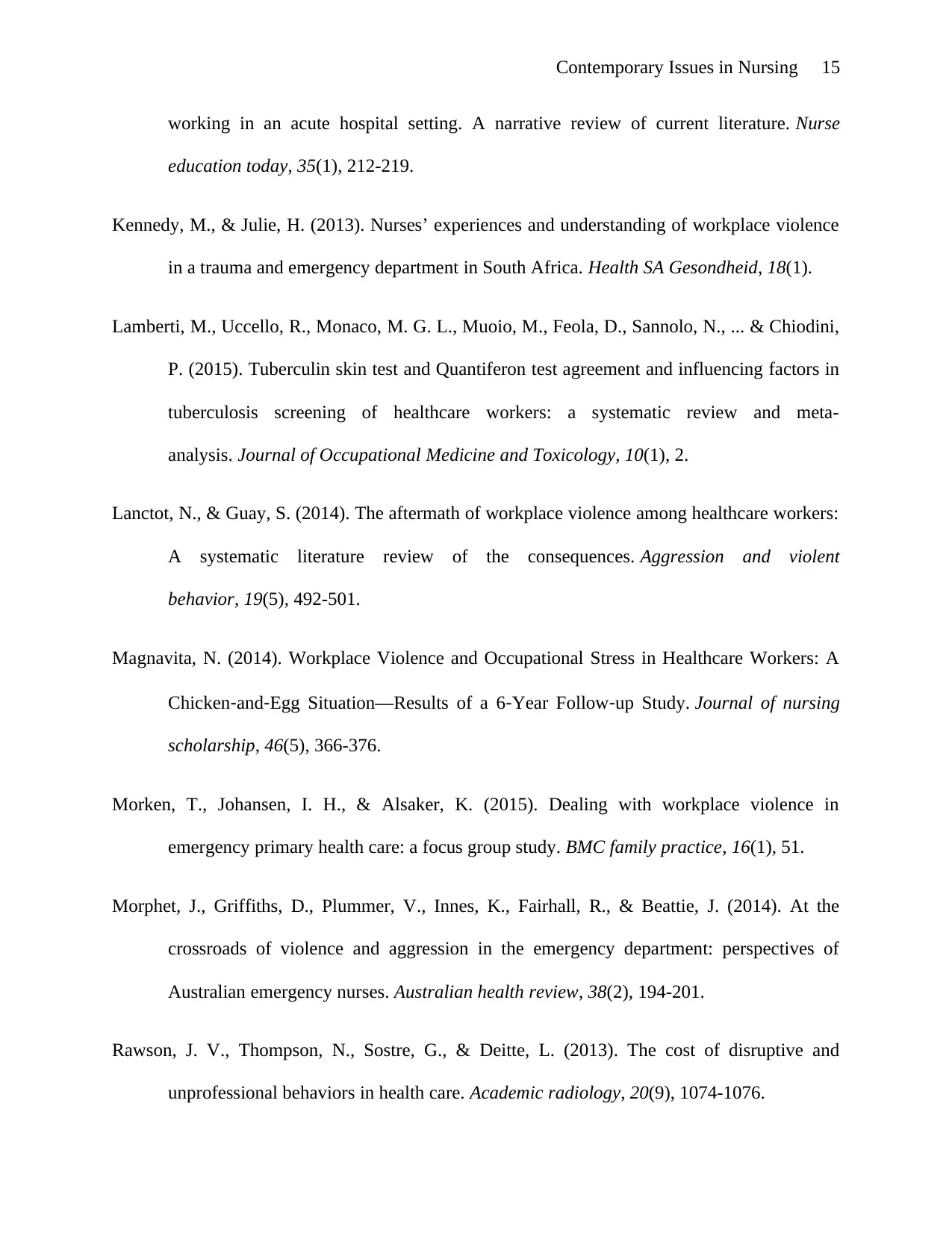
Contemporary Issues in Nursing 15
working in an acute hospital setting. A narrative review of current literature. Nurse
education today, 35(1), 212-219.
Kennedy, M., & Julie, H. (2013). Nurses’ experiences and understanding of workplace violence
in a trauma and emergency department in South Africa. Health SA Gesondheid, 18(1).
Lamberti, M., Uccello, R., Monaco, M. G. L., Muoio, M., Feola, D., Sannolo, N., ... & Chiodini,
P. (2015). Tuberculin skin test and Quantiferon test agreement and influencing factors in
tuberculosis screening of healthcare workers: a systematic review and meta-
analysis. Journal of Occupational Medicine and Toxicology, 10(1), 2.
Lanctot, N., & Guay, S. (2014). The aftermath of workplace violence among healthcare workers:
A systematic literature review of the consequences. Aggression and violent
behavior, 19(5), 492-501.
Magnavita, N. (2014). Workplace Violence and Occupational Stress in Healthcare Workers: A
Chicken‐and‐Egg Situation—Results of a 6‐Year Follow‐up Study. Journal of nursing
scholarship, 46(5), 366-376.
Morken, T., Johansen, I. H., & Alsaker, K. (2015). Dealing with workplace violence in
emergency primary health care: a focus group study. BMC family practice, 16(1), 51.
Morphet, J., Griffiths, D., Plummer, V., Innes, K., Fairhall, R., & Beattie, J. (2014). At the
crossroads of violence and aggression in the emergency department: perspectives of
Australian emergency nurses. Australian health review, 38(2), 194-201.
Rawson, J. V., Thompson, N., Sostre, G., & Deitte, L. (2013). The cost of disruptive and
unprofessional behaviors in health care. Academic radiology, 20(9), 1074-1076.
working in an acute hospital setting. A narrative review of current literature. Nurse
education today, 35(1), 212-219.
Kennedy, M., & Julie, H. (2013). Nurses’ experiences and understanding of workplace violence
in a trauma and emergency department in South Africa. Health SA Gesondheid, 18(1).
Lamberti, M., Uccello, R., Monaco, M. G. L., Muoio, M., Feola, D., Sannolo, N., ... & Chiodini,
P. (2015). Tuberculin skin test and Quantiferon test agreement and influencing factors in
tuberculosis screening of healthcare workers: a systematic review and meta-
analysis. Journal of Occupational Medicine and Toxicology, 10(1), 2.
Lanctot, N., & Guay, S. (2014). The aftermath of workplace violence among healthcare workers:
A systematic literature review of the consequences. Aggression and violent
behavior, 19(5), 492-501.
Magnavita, N. (2014). Workplace Violence and Occupational Stress in Healthcare Workers: A
Chicken‐and‐Egg Situation—Results of a 6‐Year Follow‐up Study. Journal of nursing
scholarship, 46(5), 366-376.
Morken, T., Johansen, I. H., & Alsaker, K. (2015). Dealing with workplace violence in
emergency primary health care: a focus group study. BMC family practice, 16(1), 51.
Morphet, J., Griffiths, D., Plummer, V., Innes, K., Fairhall, R., & Beattie, J. (2014). At the
crossroads of violence and aggression in the emergency department: perspectives of
Australian emergency nurses. Australian health review, 38(2), 194-201.
Rawson, J. V., Thompson, N., Sostre, G., & Deitte, L. (2013). The cost of disruptive and
unprofessional behaviors in health care. Academic radiology, 20(9), 1074-1076.
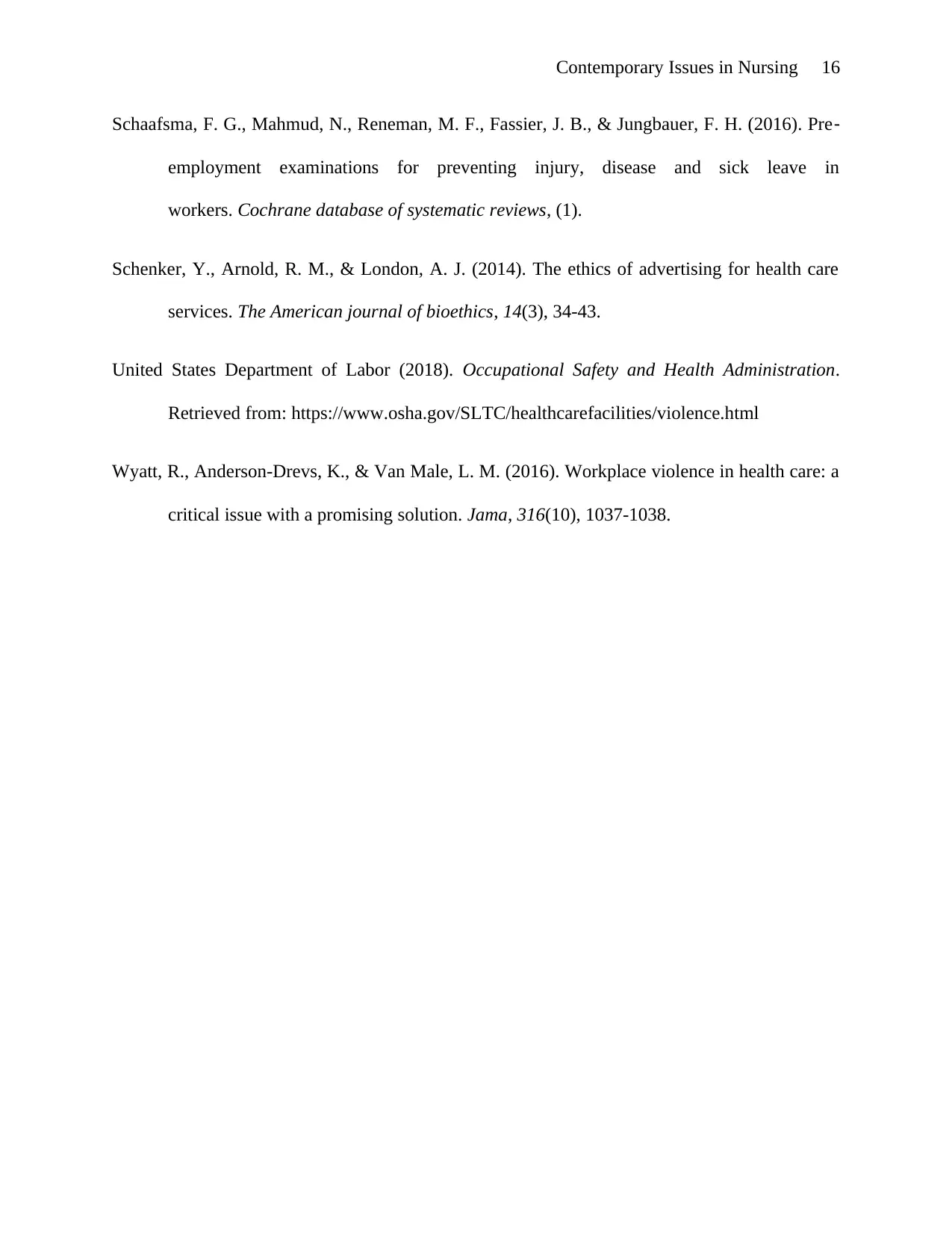
Contemporary Issues in Nursing 16
Schaafsma, F. G., Mahmud, N., Reneman, M. F., Fassier, J. B., & Jungbauer, F. H. (2016). Pre‐
employment examinations for preventing injury, disease and sick leave in
workers. Cochrane database of systematic reviews, (1).
Schenker, Y., Arnold, R. M., & London, A. J. (2014). The ethics of advertising for health care
services. The American journal of bioethics, 14(3), 34-43.
United States Department of Labor (2018). Occupational Safety and Health Administration.
Retrieved from: https://www.osha.gov/SLTC/healthcarefacilities/violence.html
Wyatt, R., Anderson-Drevs, K., & Van Male, L. M. (2016). Workplace violence in health care: a
critical issue with a promising solution. Jama, 316(10), 1037-1038.
Schaafsma, F. G., Mahmud, N., Reneman, M. F., Fassier, J. B., & Jungbauer, F. H. (2016). Pre‐
employment examinations for preventing injury, disease and sick leave in
workers. Cochrane database of systematic reviews, (1).
Schenker, Y., Arnold, R. M., & London, A. J. (2014). The ethics of advertising for health care
services. The American journal of bioethics, 14(3), 34-43.
United States Department of Labor (2018). Occupational Safety and Health Administration.
Retrieved from: https://www.osha.gov/SLTC/healthcarefacilities/violence.html
Wyatt, R., Anderson-Drevs, K., & Van Male, L. M. (2016). Workplace violence in health care: a
critical issue with a promising solution. Jama, 316(10), 1037-1038.
1 out of 16
Related Documents
Your All-in-One AI-Powered Toolkit for Academic Success.
+13062052269
info@desklib.com
Available 24*7 on WhatsApp / Email
![[object Object]](/_next/static/media/star-bottom.7253800d.svg)
Unlock your academic potential
© 2024 | Zucol Services PVT LTD | All rights reserved.





